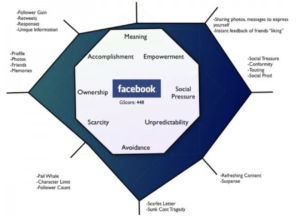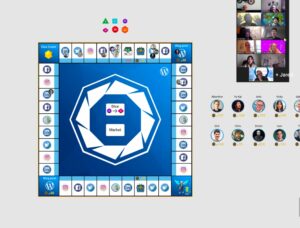Many employees are constantly on Social Media, yet they rarely post about their companies or industry. Posting about their social life is just so much more engaging it seems. But companies lose out on a major Social Media marketing resource by not utilising their workforce well enough.
Do you want to know how you can make your employees motivated to post, write, and tweet about your company? I will show you how you can change this by making it truly engaging and even fun..
This article is based on the knowledge of the Octalysis Framework by Yu-kai Chou which mentions the 8 Core Drives of Human Motivation. If you are totally new to the framework, we recommend checking the basics here before you go any further.

Core Drive 1: Make Social Media meaningful
Many companies expect their employees to be active on Social Media. Whether they are in sales, marketing or product management, having a Social Media profile and being active is now an integral part of many job descriptions. Utilising this resource well can have a huge impact on the brand image of the company.
One of the biggest mistakes that companies and their employees can make is to focus too much on getting Social Media posts out without creating a Company Social Media profile that embodies a higher purpose. Most company profiles are dull and without character, like a book without pages. It’s like building a company without a reason for the product or service.
Feeling like you are part of something bigger than yourself makes us feel good and in control. We already wrote about how Epic Meaning and Calling can super charge your employees here, if you want to learn more. Having a higher purpose in your Social Media strategy makes people more motivated. As example you could make them a spokesperson in their industry or field of expertise. Or they could become a company ambassador for fighting for equality can really make people go the extra mile.
Therefore it is highly important to make sure the creators define their vision and mission for their profiles clearly to avoid getting stuck in the follower counts.
Example: Give your employees the task to think about what’s important to them in life related to their job. As a prompt for posts, ask them what inspired them to work here, or what has them excited for the future of the company. Perhaps their goals were to help others learn about a specific topic. Improving life for others, or just showing what a great work ethic could look like. All employees have higher purposes in life than just earning an income.

Core Drive 2: Create reachable quests and give feedback
Setting some reachable goals to feel accomplished will create a feeling of progression for your employees. What we can learn from Games is that they give us instant feedback and adapt the quests towards our skill levels. For that we can use Mihaly Csikszentmihalyi’s Flow Model. We always need to be sure we create quests based on the right skill levels. When challenge matches skills we can reach a state of flow. Not too easy but not too hard either. Think about Golf. If it was designed for efficiency, you’d just pick up the ball and drop it in the hole. Efficient, but no fun, and no skill. We make golf challenging on purpose. We add in new hazards and stroke limits to make it harder. But we set the Par, at a “reasonable” number so that even non-experts can feel accomplished.

Example: With the Octalysis Group, we started a Social Media Board Game. We choose our 2 main Social Media platforms we want to focus on. There are minimum requirements to reach every week: sharing content 3 times on those chosen platforms. Further, each week, we roll a dice to determine on which field we will land. This will determine which Social Media platform will be our special quest. Having quests laid out that way gives the employee a feeling of progression. It gives them feedback on how they were doing even if they didn’t gain followers.

Core Drive 3: Allow for creativity and strategy on Social Media
As mentioned earlier, it’s not just about followers and likes. It’s also about the strategy to drive engagement. People need ways to express their creativity. They need to be able to see the results, receive feedback, and respond in turn. How much room do you allow for creativity and experimentation?
Give your employees the opportunity to try new things and find out what works best for them. This will lead to long term engagement not just for the employee, but also for the audience.
It will also lead to a greater feeling of Ownership and Possession, which will be our next Core Drive.
Example: Give them the freedom to choose which platform suits best to them. Allow them to strategise which content to share and at what times and frequencies. Let them share their findings and analyse and exchange those with other employees.

Core Drive 4: Let them build their own brand
Allowing people to build their own brand this is motivated directly by Core Drive 3, Empowerment of Creativity and Feedback which we mentioned earlier. This goes hand in hand with Core Drive 1, Epic Meaning and Calling. The brand often reflects these two Core Drives in the way the brand image is portrayed and executed.
Once they have built up a strategy and brand they are much more likely to feel attached towards their creations. This will make them stand out more and make them understand their own strengths and personalities better. It will also help them create more ownership when developing their Social Media Strategy plan. It’s like a painter that needs to sell their original artwork. Many artists struggle with that as their creations have a personal value.
The same happens with Social Media. Once they create their profile and invest time and energy into perfecting it and get a follow they will feel a sense of Core Drive 8, Loss and Avoidance.
They are scared of losing what they have built up.
Example: Let your employees choose how their brand should be perceived. To build a brand, let them think about their niche and what people would be interested in it. Let them think about the use of language, the imagery, the colours and feel in which they want to express their character in.

Core Drive 5: Make it a Group effort
I hear from a lot of influencers and public figures that their fans are what keeps them motivated. The people that comment on their posts, that cheer them on to create more content and that send them encouraging messages about how they changed their wellbeing.
But we might not all be able to start out with a huge Social Media follow. So what can we do in that case?
At the Octalysis Group we work with a weekly draw of Success Buddies. This means our actions will not just benefit us but will also benefit our partner and vice versa. This creates a positive culture of helping and motivating each other.
Group quest can also improve the team work in your company by creating meaningful interactions and group spirit for a special cause or to solve a specific problem. Important is not to make colleagues work against each other but to work together on a common goal.
Example: Social Media is not about one person, that’s why it’s called Social Media. Motivate your employees to share each other’s creations and value them by creating incentives that strengthen the group. Maybe there is an incentive that the whole group can strive for. Make the actions of a single person count towards supporting their team or buddy instead of just fighting with gaining followers and likes by themselves. Wouldn’t it be great if your first Social Media post already had 5 likes, and wouldn’t it feel great to get them from your team as a sign of appreciation?

Core Drive 6: Make them unlock scarce rewards for high performance on Social Media
Often people that outperform don’t receive a special treatment as it is a scarce phenomenon and there are no company rules set up to motivate that behaviour. But wouldn’t you like all your employees to strive to perform higher than anyone expects them to do? And even better, be motivated and happy to do so? What if they create a full Social Media Strategy plan for the next months because they are so excited and motivated about the topic? That would be of incredible value for the company if leveraged correctly.
Unlike the common thinking of giving people Stuff like a raise, a voucher or an expensive gift, things like Status, Access and Power can be much easier to give out and more efficient when it comes to motivation (SAPS). Even more, making some of the really hard to reach achievements feel special to the receiver will motivate them to perform better and be more excited to reach them.
Example: In the Octalysis Group Social Media Game, members have the chance to choose a very easy quest with minimal payout vs. a really hard quest with high payout. The higher tier incentives are very scarce to get and might even be limited to a few users that get them first. As they are really hard to get, it will also create more of a feeling of Accomplishment, Core Drive 2, Development and Accomplishment.
Core Drive 7: Create curiosity
Doing Social Media can be a really linear experience. Giving your team some random events every week, creating a lottery system or other rewards based on Unpredictability and Curiosity can create a longer lasting engagement.
Example: Roll a dice every week for special events. For all the Dungeons and Dragons players, this reminds us of rolling for special events or ability checks. If a special event occurs, you could add some Core Drive 3, Empowerment of Creativity and Feedback to make people choose their level of Social Media proficiency. This would make sure the level suits the ability of the employee.
Actually, this article was written because of such a challenge and I chose to do the hardest challenge purely because it was a secret what the challenge was. All I knew was that it would be extremely hard to accomplish.

Core Drive 8: Set deadlines
Let’s not forget that we all need a little bit of structure. It’s nice to do meaningful work and be creative, but if we don’t have a nudge that tells us to start or finish a project in time, we can procrastinate for days, weeks or even months.
That’s where Loss and Avoidance through deadlines can be really helpful and should be part of every Social Media Strategy plan.
An important side note is that letting “deadlines’ pass is mainly Core Drive 6, Scarcity and Impatience, but the punishment related to failing the deadline is Core Drive 8, Loss and Avoidance.
Example: Create rounds each week where you can do the quests and you will need to finish them in that week only to get a scarce reward (which is Core Drive 6: Scarcity and Impatience). You could also set a small penalty for not doing minimum requirements like 3 posts a week. Just be sure those minimum requirements are easy to reach for everyone in the team.
Key Takeaway
Octalysis Gamification can help you to create a work environment to motivate Social Media activities that are engaging long-term and can have a positive impact on your company culture and team spirit.
Knowing about the Core Drives that motivate people can make a difference between Social Media activities that are exciting and motivating and frustrating or even depressing.
If you want to make a difference in your company’s Social Media activities contact me via sabrina@octalysisgroup.com



